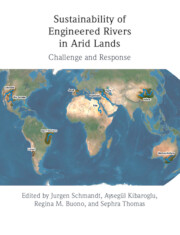23 results
1 - Introduction
- from Part I - Introduction
-
-
- Book:
- Sustainability of Engineered Rivers In Arid Lands
- Published online:
- 16 September 2021
- Print publication:
- 16 September 2021, pp 3-10
-
- Chapter
- Export citation
19 - Conclusion
- from Part V - Conclusion
-
-
- Book:
- Sustainability of Engineered Rivers In Arid Lands
- Published online:
- 16 September 2021
- Print publication:
- 16 September 2021, pp 273-281
-
- Chapter
- Export citation
Part I - Introduction
-
- Book:
- Sustainability of Engineered Rivers In Arid Lands
- Published online:
- 16 September 2021
- Print publication:
- 16 September 2021, pp 1-10
-
- Chapter
- Export citation
Contributors
-
- Book:
- Sustainability of Engineered Rivers In Arid Lands
- Published online:
- 16 September 2021
- Print publication:
- 16 September 2021, pp viii-x
-
- Chapter
- Export citation
Dedication
-
- Book:
- Sustainability of Engineered Rivers In Arid Lands
- Published online:
- 16 September 2021
- Print publication:
- 16 September 2021, pp v-vi
-
- Chapter
- Export citation
Part IV - Response
-
- Book:
- Sustainability of Engineered Rivers In Arid Lands
- Published online:
- 16 September 2021
- Print publication:
- 16 September 2021, pp 233-270
-
- Chapter
- Export citation

Sustainability of Engineered Rivers In Arid Lands
- Challenge and Response
-
- Published online:
- 16 September 2021
- Print publication:
- 16 September 2021
18 - Better Basin Management with Stakeholder Participation
- from Part IV - Response
-
-
- Book:
- Sustainability of Engineered Rivers In Arid Lands
- Published online:
- 16 September 2021
- Print publication:
- 16 September 2021, pp 260-270
-
- Chapter
- Export citation
Copyright page
-
- Book:
- Sustainability of Engineered Rivers In Arid Lands
- Published online:
- 16 September 2021
- Print publication:
- 16 September 2021, pp iv-iv
-
- Chapter
- Export citation
Part II - Challenge
-
- Book:
- Sustainability of Engineered Rivers In Arid Lands
- Published online:
- 16 September 2021
- Print publication:
- 16 September 2021, pp 11-76
-
- Chapter
- Export citation
Contents
-
- Book:
- Sustainability of Engineered Rivers In Arid Lands
- Published online:
- 16 September 2021
- Print publication:
- 16 September 2021, pp vii-vii
-
- Chapter
- Export citation
Part III - Engineered Rivers
-
- Book:
- Sustainability of Engineered Rivers In Arid Lands
- Published online:
- 16 September 2021
- Print publication:
- 16 September 2021, pp 77-232
-
- Chapter
- Export citation
14 - The Rio Grande / Río Bravo Basin
- from Part III - Engineered Rivers
-
-
- Book:
- Sustainability of Engineered Rivers In Arid Lands
- Published online:
- 16 September 2021
- Print publication:
- 16 September 2021, pp 181-219
-
- Chapter
- Export citation
Part V - Conclusion
-
- Book:
- Sustainability of Engineered Rivers In Arid Lands
- Published online:
- 16 September 2021
- Print publication:
- 16 September 2021, pp 271-281
-
- Chapter
- Export citation
Index
-
- Book:
- Sustainability of Engineered Rivers In Arid Lands
- Published online:
- 16 September 2021
- Print publication:
- 16 September 2021, pp 282-294
-
- Chapter
- Export citation
Preface
-
-
- Book:
- Sustainable Development
- Published online:
- 17 August 2009
- Print publication:
- 13 April 2000, pp xv-xvi
-
- Chapter
- Export citation
List of contributors
-
- Book:
- Sustainable Development
- Published online:
- 17 August 2009
- Print publication:
- 13 April 2000, pp vi-x
-
- Chapter
- Export citation
10 - From idea to action: The role of policy
-
-
- Book:
- Sustainable Development
- Published online:
- 17 August 2009
- Print publication:
- 13 April 2000, pp 203-220
-
- Chapter
- Export citation
Frontmatter
-
- Book:
- Sustainable Development
- Published online:
- 17 August 2009
- Print publication:
- 13 April 2000, pp i-iv
-
- Chapter
- Export citation
Contents
-
- Book:
- Sustainable Development
- Published online:
- 17 August 2009
- Print publication:
- 13 April 2000, pp v-v
-
- Chapter
- Export citation

